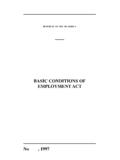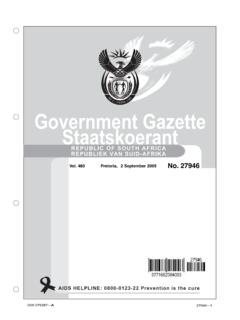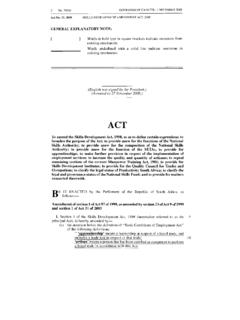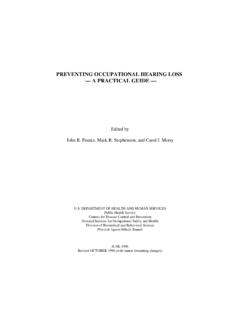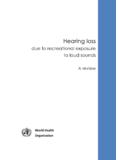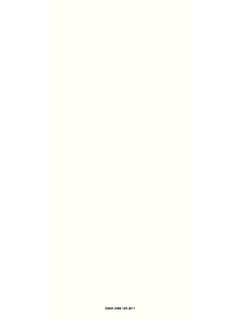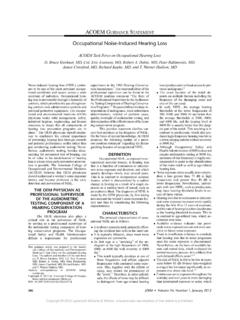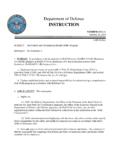Transcription of Noise Induced Hearing Loss and Conservation in 8 Primary ...
1 Noise Induced Hearing loss and Hearing Conservation in 8 Primary Iron and Steel Companies in South AfricaPresenters: Dr Odette AbrahamsGabriel MizanBackgroundNoise: Sound that is undesirable, either because it annoys, distracts or interferes with those Hearing it or because it has the potential to damage the Hearing mechanism of those exposed to it SA Dept of Mineral and Energy (2000) Noise Induced Hearing loss (NIHL) Cumulative, permanent loss of Hearing that develops gradually after months or years of exposure to high levels of Noise Commonest compensable occupational disease globally One of the major avoidable causes of permanent Hearing impairment worldwide WHO estimated that occupational NIHL costs approximately to 2% of the GDP of developed nationsFactors Affecting Employees Susceptibility to NIHL Intensity of the Noise (dB) Temporal pattern of the Noise (continuous, intermittent) Spectral pattern of the Noise (frequency content) Duration of exposure Individual susceptibility to Noise (age , ear infection, certain medication)
2 Statutory Requirements NIHL Regulations, promulgated under the OHSAct 85 of 1993 require the employer to implement HCP when workers are exposed to Noise rating limit > 85 dB (A) Compensation for Occupational Injuries and Diseases Act No 130 of 1993 compensable at or above PLH of 10 % as per Schedule 3 Circular Instruction 171 provides further guidance on compensation of employeesThe StudyNIOH was commissioned by the DoL to investigate Noise exposure levels and NIHL in the Primary Iron and Steel in South Africa Iron and Steel industry in one of the largest employers in SA with approximately 55 000 employees South Africa is the 21stlargest crude steel producing in the world ( m tonnes /year) Iron and Steel manufacturing is one of the noisiest industries and NIHL is commonStudy verify the current designation of Noise zones as described in companies occupational hygiene reports2. To verify workers Noise exposure levels by taking spot area measurements and personal Noise exposure (dosimetry)3.
3 To analyse and audit current Hearing Conservation practices4. Based on company records, to determine the extent of NIHL diagnosed by the companies over the past decadeStudy Objectives5. To verify records of current Hearing threshold levels of workers by independently conducting audiometric testing6. To compile recommendations for improvement of existing Hearing Conservation practices that can be implemented in the South African iron and steel industry7. Based on best practices and expert advice, to develop a standard inspector checklist for Noise in the iron and steel industry MethodologyMethodologyCross sectional survey in 8 major iron and steel companies across SACompanyType of industryNo of permanent employeesNo of contract employeesCompany APrimary steel plant70006808 Company BPrimary steel plant541328 Company CPrimary steel plant650753 Company DSecondary steel plant2466 Company EPrimary steel plant27002100 Company FPrimary steel plant25872354 Company GPrimary steel plant1696 450- 500 Company HPrimary steel plant2711310 Phase 1: Occupational Hygiene Study Walkthrough / task observations Interviews with H&S personnel, workers, clinic Area (spot) Noise measurements Personal Noise measurements (dosimetry) Review of previous Noise survey reports and other relevant documentationH&S Manager QuestionnaireCovered various aspects of HCP including.
4 Information and training Assessment of exposure Survey report and recommendations Medical surveillance Hearing protection equipment Policies and procedureWorker s InterviewQuestionsInput / ObservationWhen were you last given training on Noise ?What are the main health risks of Noise ?Do you use Hearing protection in your job?What type of Hearing protectors do you use?Will you show me how do you put on Hearing protectors correctly?When last did you have a Hearing test?Do you experience any difficulties with your Hearing ?Do you have any concerns regarding Noise in this workplace?Phase 2: Occupational Medicine Hearing Conservation Policy Interview check list used Copy of the company policy Interview was then compared to the written policy Medical Record Review Review of NIHL Audiometric verificationResponse Rate CompanyResponse rate in the chosen departmentResponse rate in the NIHL employeesResponse rate for audiometric retestingCompany A100%100% B100%100% C100%a89%Company DNot ascertainedbCompany Employee records were available but not all were reviewed due to time Employees consent for review of records was only concluded during the survey and hence a random sample could not be Policy on Hearing Conservation ProgrammeABCDEFGHE xposure Assessment / Noise Risk Assessment+----++++----+Identification of employees at risk+----++++----+ Noise Monitoring & Assessment++++++----+ Noise Control+----++++----+Employee Training & Education++++++----+Baseline& Periodic Audiometric
5 Testing ++++++----+Assessment of Noise exposureArea measurements: 78% of measurements in the Iron & Steel Industry departments exceeded the 85 dB (A) limitPersonal Noise dose measurements: 68% of exposures exceeded 85 dB (A)FactoryAverage Noise level dB(A) per Department Steel Production & BOF Coke plant &cutting areaCold Mill Galvanizing & Temper Mill Sinter Plant A8486929498 Off line (Recycle)Melt ShopMillsB9494102 Iron making, Corex&MidrexHot Strip MillHot Strip BasmntSteel Mill Melt ShopC87889095 QCSmall parts & Core ShopSand PlantFettling & VW Production Foundry & Prod D819494102102 Coke Plant & Steel PlantUnitrans Bar MillBillet Bar Rod MillIron Blast FurnaceE88909497 Structures Work ShopIron Plant Melt Shop Flat ProductsSteel Plant 1 & 2 & MillPulverized FuelF7885889098 Hot & Cold Process LinesFinal LinesPlate Process & cuttingSteel PlantG839299106 Foundry Heavy & Ball ForgeFoundry MediumMelt ShopsHille Mille, Morgan & DRI Pl & HCBPH85939596103 Area Noise MeasurementsNoise Measurements AreaThe distribution of 406 area Noise measurements in dB(A).
6 1459675602010<85>85 & <90>90 & <95>95 & <100>100 & <105>105 Noise Measurements DosimetryThe distribution of 127 personal Noise dose measurements in dB(A):304429204<85>85 & <90>90 & <95>95 & <100>100 MSOffice5 Slide 21 MSOffice5 The cake slice for <85 is too large there should be less than half. , 2012/10/180102030405060708090100 ABCDEFGHP ercentage >85 dB(A)FactoryPercentage area and personal Noise measurements >85dB(A) at eight Iron and Steel factoriesArea noisePersonalnoise doseNoise Control Practices Reusable ear plugs, ear muffs and custom made HPDs were used Noise control engineering options were not used to their fullest advantage Double glazed Noise refuge control room Information and Training All companies had an information and training programme conducted by health & safety officers or SAQA accredited trainers Training within the 1st year of employment and on moving to a noisy department with > 85dB(A) Training was initially done at induction and then annually in 6 of 8 companiesInformation and Training 43 out of 111 (39%)
7 Workers interviewed could not remember when last trained on Noise 96% of workers interviewed understood the health risk related to Noise 39% of workers could not demonstrate how to fit their HPDs correctly 27% of the workers were concerned about Noise in their work environment 11% reported problems with their hearingMedical SurveillanceAll 8 companies conducted baseline, periodical and exit audiogramsBaseline Audiometric Testing0%10%20%30%40%50%60%70%80%90%100% A BCDE FGH98%93%97%68%98%93%86%69%2%7%3%32%2%7% 14%32%Baseline done in accordance with Instructiion 171 CompaniesYesNoPeriodic Audiometric Testing0%10%20%30%40%50%60%70%80%90%100% ABCDEFGH98%72%100%0%100%0%100%11%2%28%0% 100%0%0%89%% Compliance with frequency of periodic audiometric testing CompaniesyesNoPeriodic Audiograms: Evidence of PLH shift0%10%20%30%40%50%60%70%80%90%ABCDEF GH17%46%32%14%36%37%28%48%0%10%84%0%Evid ence of threshold shift from baseline on periodic audiogram CompaniesYesNoUnclearRecorded Actions Following Evidence of Hearing DeclineEvidence of threshold shift : no of employeesNothing recorded in the medical fileTest was repeated after no exposure to noiseDiagnostic audiogram was doneMore training was doneThe employee was relocatedA1020%40%60%10%0B 3792%8%08%0C1173%09%23%0 DaUnobtainableE2176%15%9%00F1050%10%050% 0G2696%4%04%0H617%33%67%00 Noise Induced Hearing average annual incidence(per 1000/year)Ha Calculated over from 2008 for Company Recorded Actions Following NIHL Diagnosis Company No.
8 Of employees with NIHLR eferred for compensationMore trainingRelocation DismissedOther than referral for compensation, no evidence of other actionsA37100%22%11%068%B2186%000100%C91 00% No consent grantedD10100%No consent grantedE7100%14%29%00F786% 43%0057%GNo consented obtainedH683%00033%Audiometric verificationAim:To compare a sample of audiograms done in house at each company with audiograms done by an external service provider on the same employees. Audiometric verification ABCDEFGHA udiograms for comparison 1620201924212012 Concordant8040224010 19 dB difference33107111414620 29 dB difference5769832430 39 dB difference04013102>40 dB difference06020100 Limitations Industrial action affected response rate adversely OH measurements could not be done of every activity Incomplete medical records Extent of NIHL company records of cases over the past 10 years were used (underestimation) Reliance on companies to provide cases of NIHL (validation)
9 Only permanent employeesLimitationsAudiometric verification Currently no reference body for audiometric testing in the workplace No gold standard testing facility Measured repeatability rather than of validity External provider chosen based on calibrated equipment and a national footprint Many factors affect repeatability however this indicates that a review of quality assurance and testing procedures by in house testers is requiredConclusion All companies included in this survey had areas of Noise exposure above the legislated level of 85dB(A) which put a number of employees at risk of developing NIHL Difference between the companies lies in the effective implementation of the Hearing Conservation programme Highlights the need for proper implementation of Hearing Conservation practices known to be effective and establishment of effective monitoring and evaluation systemsGood Practices:Policy and procedures Written health and safety policies are available (7/8) Hearing Conservation related matters reported discussed by employees during toolbox talks and in committee meetings (8/8) Proactive Hearing Conservation programmes demonstrated noticeable outcomes (2/8) Managers seen to be committed to the Noise Conservation programme (4/8)Good PracticesAssessment of Noise Exposure Assessments re done after major changes made in work systems and machinery (8/8) Records of these were made available to Safety Representatives and Safety Committee (8/8) Recommendations in reports were practical and actioned according to a plan in line with hierarchy of control (5/8)Good Practices:AIA Survey reports and recommendations AIAs were used in the Noise exposure assessments (8/8) Reports were available and repeated on the average every 24 months (6/8)Good Practices.
10 Noise Control Practices Good general maintenance of machinery, equipment and tools led to less Noise (3/8) Custom made HPDs were provided to selected employees, notably those with early decline in Hearing or based in areas with very high Noise exposure (5/8) Signage and Noise zoning is implemented (8/8) SOPs on Noise control were available (4/8)Good Practices: Information and Training Specialised Noise training sessions Training content was in line with the appropriate medical surveillance programme Training records were kept (4/8) Refresher training was conducted annually (3/8) Information and training programmes delivered by competent persons (8/8) Strategies in place to increase uptake of training with objective means (tests) to evaluate effectiveness of training (4/8) Incentive schemesfor employees who (1/8): completed training show evidence of understanding informationGood Practices:Medical Surveillance Occupational Medicine & Occupational Hygiene services share information and updates on Noise exposure levels (2/8) Baseline and periodical audiograms are done in accordance with SANS 10083 (5/8) Software is utilised to analysis aggregated audiometric results of audiometric testing in order to identify any trends suggesting review of workplace controls (2/8) Documentation of Noise exposure & management s intention for each employee with results that need to be acted upon (3/8)Good Practices:Medical Surveillance Individual employee audiogram analysed by OHP and OMP to identify permanent or temporary threshold shift (8/8) Early intervention by clinic staff on Hearing loss before 10 PLH is reached (some companies action is taken at 5 PLH ) (4/8) OM staff give feedback to Occupational Hygiene and Safety services and employee representatives (2/8)Good Practices.
